Micflex

Micflex is a multi-mode adaptive microphone processor that intelligently adapts to your mix environment and provides processed audio with up to 10dB more gain before feedback, all while maintaining the natural sonic qualities of your audio sources.
Links
Quick Start Video
Quick Start Guide
1 - Install VUI
- Download the latest version of VUI on a computer connected to your Dante™ network.
2 - Connect and Power Up
- Mount the Micflex unit in a rack, connect power, and connect the Network 1 port to your Dante™ network.
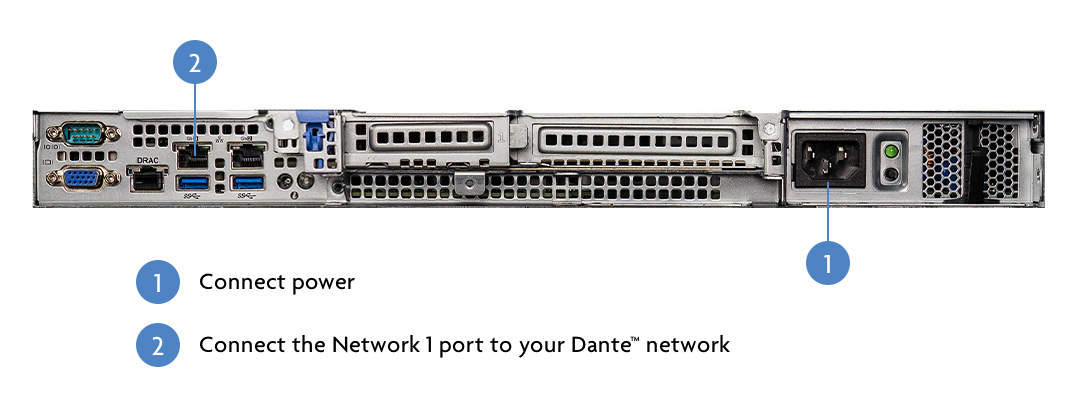
- Power the unit up by pressing the front panel power button. The unit will automatically receive an IP address (if you have a DHCP server on your network), or it will select a self-assigned address.
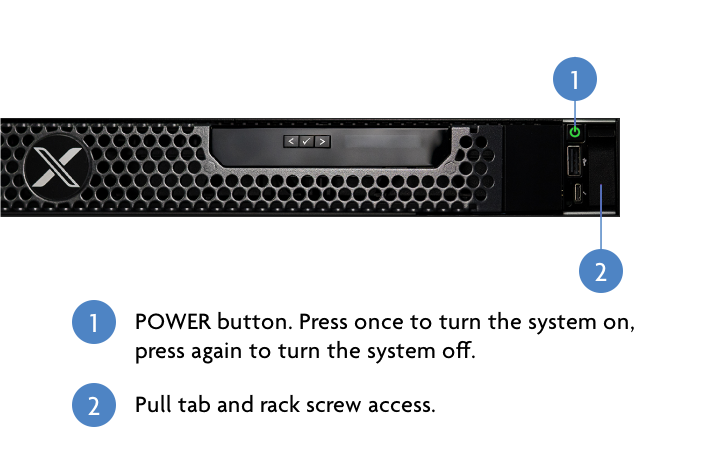
3 - Connect VUI to Micflex
-
In the VUI software, navigate to the Processors tab and search for Micflex under the Discovered list. If Micflex does not appear, check your preferred network interface.
-
Click the Discovered icon to connect.
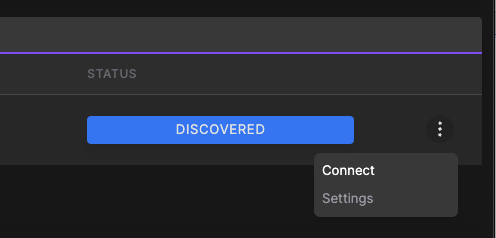
4 - Choose the Micflex system mode
Micflex operates in one of seven modes: Ensemble , Duet , Audience , Stage , Wedge , Lecture , or Sports .
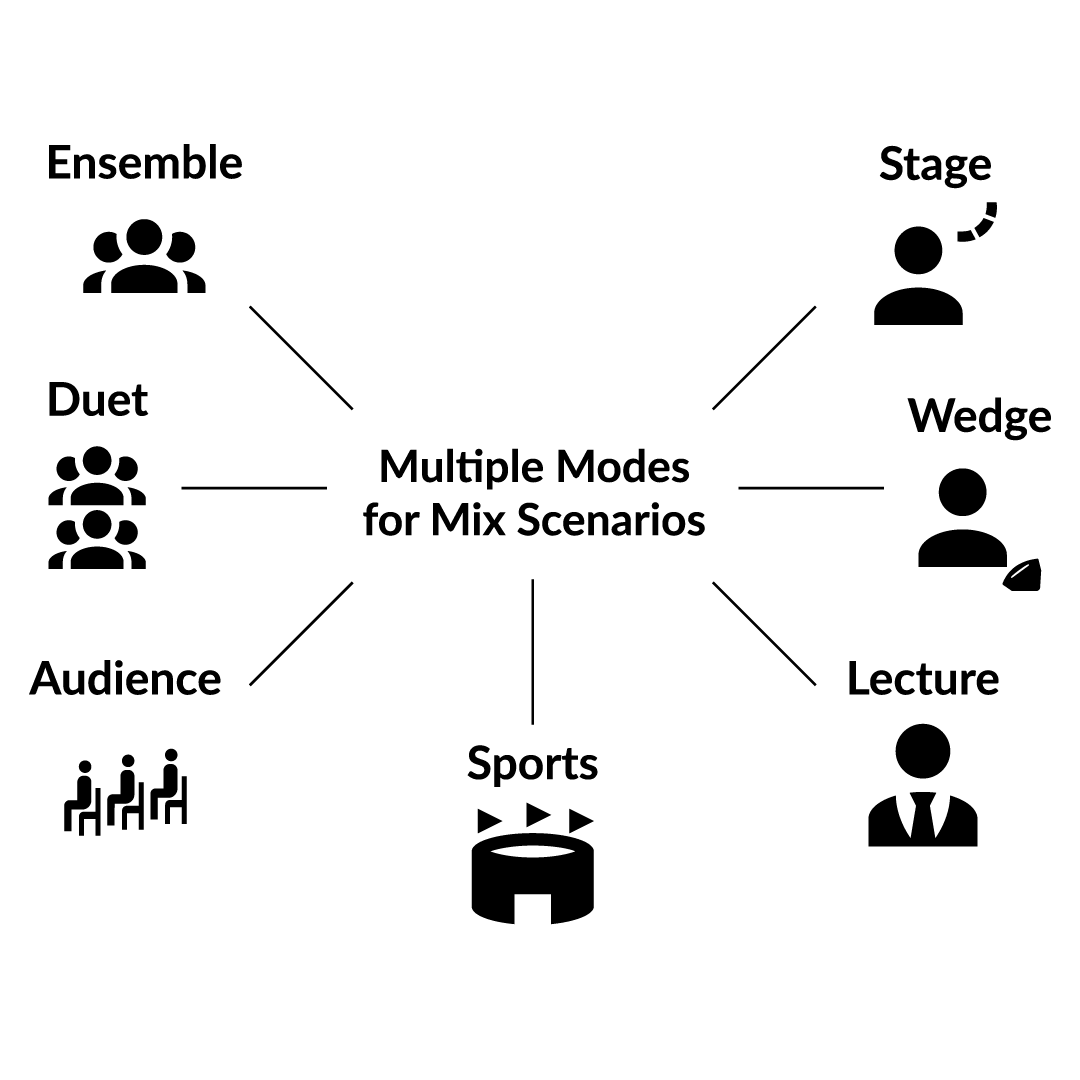
From the Processors tab, select the drop-down menu for the Micflex processor and choose Settings .
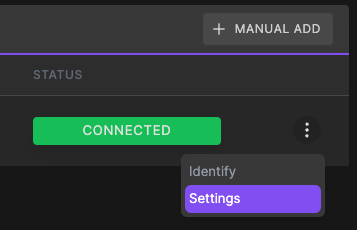
Next, choose the desired mode, and reboot the processor when prompted. Micflex will restart in the selected mode.
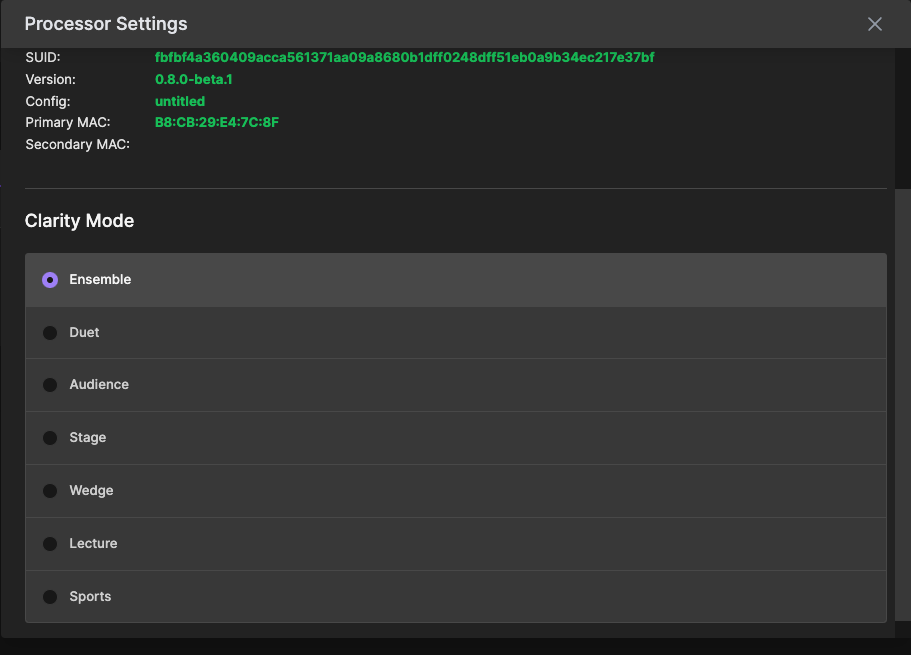
5 - Route Dante™ Audio
Dante™ Controller is used to patch audio in and out of Micflex. Route 48kHz Dante audio in and out of the processor based on the Micflex mode selected above. Dante channel patching can be found by selecting the desired mode below:
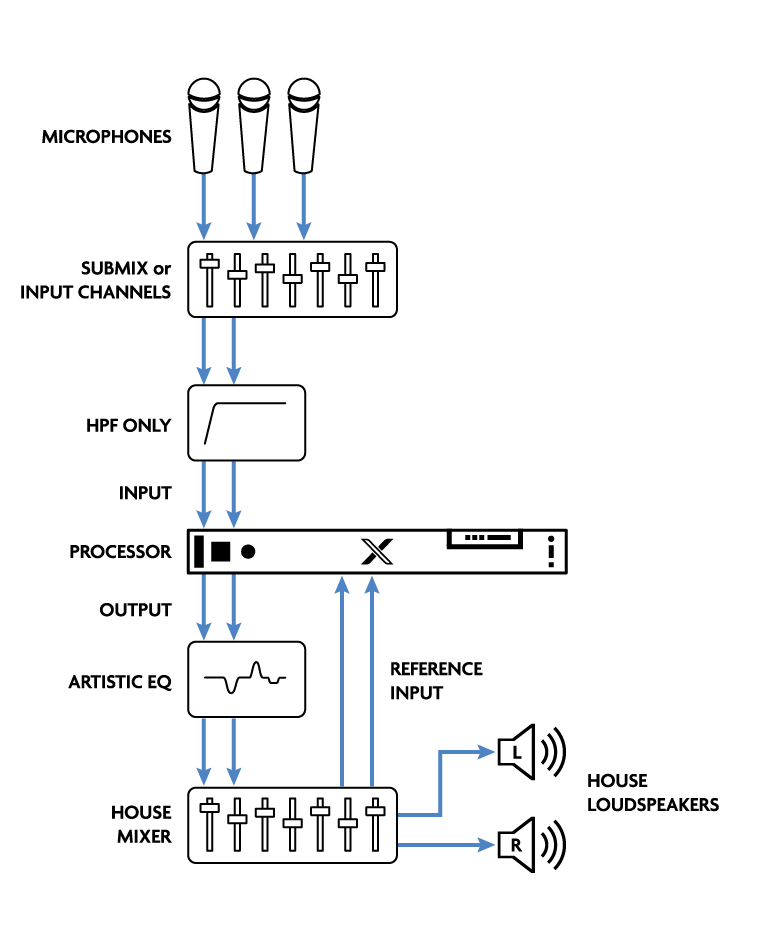
6 - Verify Levels and Console Settings
Toggle VUI to the Live tab for system monitoring.
- Set the Liveness control to full (clockwise).

- Play back audio through the system at a normal volume as used during a performance.
- Verify that all meters on VUI (inputs and outputs) are reading at similar levels. Adjust your feeds from the console as necessary.
- Slowly bring up the return channel faders or the individual mic faders to allow the processor to adapt to the room.
- Continue adjusting levels up and down as necessary, letting feedback slightly ring out through the system.
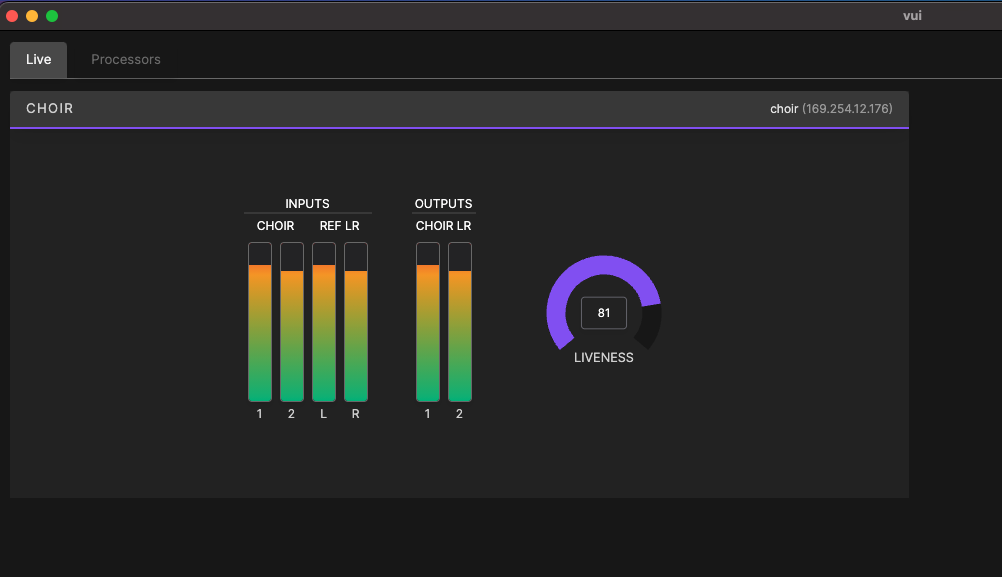
7 - Mixing
- During soundcheck, constantly monitor input gains from the mics and return channels. Adjust as necessary.
- Once Micflex has optimized it's processing, and levels are within the normal range throughout, you will only need to adjust the return level on the return channels to mix.
- You may use selective equalization on the return channels for taste and tonality. We do not recommend applying any equalization on the mic channels themselves beyond a simple high-pass filter of 60-80 Hz.
For More help please refer to our full guide on Micflex.
Manual Introduction

Providing sound reinforcement while maintaining clarity is one of the most difficult tasks in live audio. Achieving sufficient gain-before-feedback, minimizing stage volume in your vocal and instrument microphones, and keeping vocals “on top of the mix” with intelligibility are classic challenges that prove difficult to overcome.
Micflex (formerly Clarity) is a multi-mode adaptive digital signal processor that intelligently learns your venue’s acoustical environment and results in increased speech intelligibility and gain-before-feedback.
This proprietary technology is designed to increase Micflex, stability, and maintain the sonic qualities of singing vocals and spoken word. With different modes for multiple mix scenarios, audio engineers can get vocals “on top of the mix” no matter the situation.
In combination with its use in sound reinforcement, the Micflex processor is equally effective for enhancing vocals and audience microphones for broadcast and recording mixes.
Apply Micflex to vocals to increase speech intelligibility with up to 10 dB of increased gain-before-feedback.
This proprietary technology is designed to increase Micflex, stability, and enhance the sonic qualities of singing vocals and spoken word. Audio engineers can get their vocals “on top of the mix” with different mode selections created for multiple mix scenarios.

Modes of operation
The Micflex processor currently ships with seven different processing modes, each optimized for a different mix scenario. Micflex can run in any of these seven modes, but must be restarted in order to change modes. In addition, audio patching varies between modes based on the intended application.
 | Ensemble | Ensemble mode consists of one very low-latency stereo group chain optimized for increasing reinforcement system gain with choirs, orchestras, drama performance or other ensemble performance. This is equivalent to the classic Choirflex processor. |
 | Duet | Duet mode consists of two separate stereo group chains optimized for increasing reinforcement system gain with choirs, orchestras, drama performance or other ensemble performance. Duet mode has slightly higher latency than Ensemble mode. |
 | Audience | Audience mode contains processing designed to enhance the capture of audience/crowd microphones in broadcast environments with live PA systems, with up to 8 simultaneous mic channels. |
 | Stage | Stage mode contains eight separate microphone processing chains optimized for increasing reinforcement system gain with individual on-stage microphones, such as solo vocalist or instrument mics. |
 | Wedge | Wedge mode contains eight separate microphone processing chains optimized for increasing wedge monitor system gain with individual on-stage microphones coupled with individual on-stage monitor wedges. |
 | Lecture | Lecture mode contains processes microphone feeds for four separate lecture / breakout rooms, each containing two microphones. It is optimized for increasing reinforcement system gain in educational or event environments with lavalier or handheld microphones. |
 | Sports | Sports mode contains two separate microphone processing chains optimized for increasing reinforcement system gain with individual on-court/on-field microphones, such as announcer and referee mics. |

Safety & Regulatory
Important safety instructions
- Read these instructions.
- Keep these instructions.
- Heed all warnings.
- Follow all instructions.
- Do not use this apparatus near water.
- Clean only with a dry cloth.
- Do not block any ventilation openings. Install in accordance with the manufacturer’s instructions.
- Do not install near any heat sources such as radiators, heat registers, stoves, or other apparatuses that produce heat.
- Do not defeat the safety purpose of the polarized or grounding-type plug. A polarized plug has two blades with one wider than the other. A grounding type plug has two blades and a third grounding prong. The wide blade or the third prong is provided for your safety. If the provided plug does not fit into your outlet, consult an electrician for replacement of the obsolete outlet.
- Protect the power cord from being walked on or pinched particularly at plugs, convenience receptacles and the point where they exit from the apparatus.
- Use only with the accessories specified by the manufacturer or sold with the apparatus.
- Unplug this apparatus during lightning storms or when unused for long periods of time.
- Refer all servicing to qualified service personnel. Servicing is required when the apparatus has been damaged in any way, such as power-supply cord or plug is damaged, liquid has been spilled or objects have fallen into the apparatus, the apparatus does not operate normally or has been dropped.
DO NOT ATTEMPT TO OPEN THE APPARATUS ITSELF; IT IS NOT USER-SERVICEABLE.
Regulatory
This device complies with part 15 of the FCC Rules. Operation is subject to the following two conditions: (1) This device may not cause harmful interference, and (2) this device must accept any interference received, including interference that may cause undesired operation.
This equipment has been tested and found to comply with the limits for a Class A digital device, pursuant to part 15 of the FCC Rules. These limits are designed to provide reasonable protection against harmful interference when the equipment is operated in a commercial environment. This equipment generates, uses, and can radiate radio frequency energy and, if not installed and used in accordance with the instruction manual, may cause harmful interference to radio communications. Operation of this equipment in a residential area is likely to cause harmful interference in which case the user will be required to correct the interference at his own expense.
Do not attempt to power down the server without pressing the POWER button on the front panel of the server. Arbitrarily removing AC power from the server without a proper shutdown may render the server unusable or damaged.
Hardware Installation
Micflex is a digital signal processor that receives microphone audio feeds plus reference (PA signal) audio feeds, and produces enhanced return audio for reinforcement, broadcast or recording. Micflex has network-based Dante audio inputs and outputs.
Mounting
Micflex may be mounted in a standard 19-inch equipment rack, or placed on a desktop. In either case, do not cover or obstruct the ventilation ports on the front and back of the unit. The Micflex product is intended to be remotely controlled and monitored using a network connection and the VUI software, and audio routed similarly over a network. To minimize the presence of fan noise in the performance environment, we recommend mounting the Micflex processor in a remote equipment room or another area where server fan noise will not be intrusive.
Power connection
Connect the supplied power cord to the rear main power input. Do not use any power source other than the AC adapter supplied with the server, as doing so may damage the unit and void your warranty!
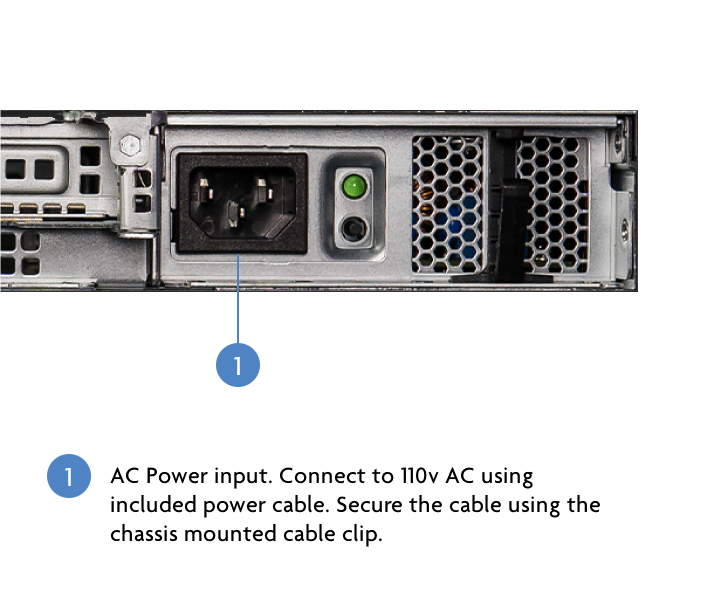
Network connections
Micflex has two ethernet ports on the rear side of the chassis. Port 1 (ONE) is used for Dante network audio and can also be used for remote control from your external computer using the VUI software. Port 2 (TWO) can be used for connection to a separate network for control and monitoring through the VUI Software. If using a single network, do not connect both ports to the same network at the same time as this may cause unstable operation!

Starting up
After connection to an appropriate power source, the POWER button may be momentarily depressed to start the processor. Upon connection of a power source, the status LED on the left side of the server will glow blue after some time, which is normal. Upon power-up, the POWER button will glow green. At any point, momentarily depress the POWER button to turn Micflex off, and wait for the unit to power off. Do not shut down Micflex by removing power to the unit before safely turning off the unit with the POWER button. Only remove power after the system has been safely shut down using the POWER button and the LED behind the POWER button is no longer illuminated.

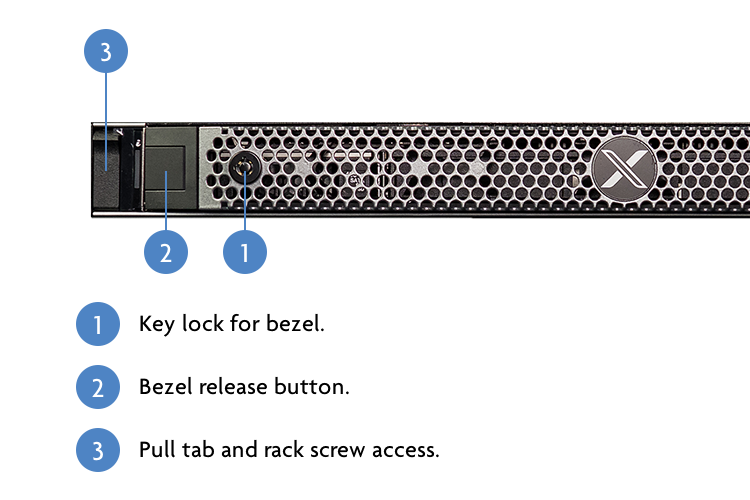
Setup and Configuration
Control software installation
VUI is software offered by Fulcrum Immersive to control and monitor Micflex installations from your computer running Windows or MacOS, and is required for proper setup and use of the Micflex processor. The following instructions assume that you already have VUI installed. If not, please refer to the VUI Getting Started guide.
Dante network audio channels must be patched using the Audinate Dante™ Controller software application. This application may be downloaded for free from Audinate™ and is available for Windows or MacOS.
Network setup
The computer containing both VUI and Dante Controller should be connected to the same network subnet as the Micflex processor for proper operation, along with any source or destination audio devices (e.g., Dante audio from your mixing console). Use a properly-configured Dante network switch or other Dante-compatible network topology for best operation.
Connecting VUI to Micflex for remote control
The following steps will guide you through connecting to your Micflex processor.
- Navigate to the Processors tab in VUI and search for it under the Discovered list. If Micflex does not appear, check your preferred network interface .
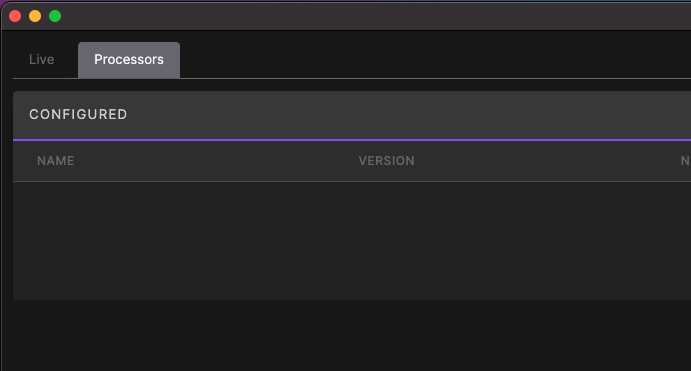
- Click the blue Discovered icon next to the Micflex processor. Optionally you can click the triple dot icon to the right and choose Connect . Either option will work.

At this point you should see your Choirflex processor listed under the CONFIGURED table. You have now successfully connected to the processor. If you weren't able to find your processor under the Discovered list and connect, refer to the Manual Connection section below

Manual connection
If the Micflex processor resides in a different network subnet from the computer running VUI, you'll need to use the Manual Add button at the top right corner of the Processors page. You will need to know the IP Address of Micflex to use this option. If Micflex appears in Dante Controller, you can find the IP Address there under the Device Info tab.
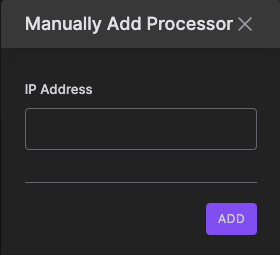
System mode selection
Micflex operates in one of seven modes: Ensemble , Duet , Audience , Stage , Wedge , Lecture , or Sports .
 | Ensemble | Ensemble mode consists of one very low-latency stereo group chain optimized for increasing reinforcement system gain with choirs, orchestras, drama performance or other ensemble performance. This is equivalent to the classic Choirflex processor. |
 | Duet | Duet mode consists of two separate stereo group chains optimized for increasing reinforcement system gain with choirs, orchestras, drama performance or other ensemble performance. Duet mode has slightly higher latency than Ensemble mode. |
 | Audience | Audience mode contains processing designed to enhance the capture of audience/crowd microphones in broadcast environments with live PA systems, with up to 8 simultaneous mic channels. |
 | Stage | Stage mode contains eight separate microphone processing chains optimized for increasing reinforcement system gain with individual on-stage microphones, such as solo vocalist or instrument mics. |
 | Wedge | Wedge mode contains eight separate microphone processing chains optimized for increasing wedge monitor system gain with individual on-stage microphones coupled with individual on-stage monitor wedges. |
 | Lecture | Lecture mode contains processes microphone feeds for four separate lecture / breakout rooms, each containing two microphones. It is optimized for increasing reinforcement system gain in educational or event environments with lavalier or handheld microphones. |
 | Sports | Sports mode contains two separate microphone processing chains optimized for increasing reinforcement system gain with individual on-court/on-field microphones, such as announcer and referee mics. |
From the Processors tab, select the drop-down menu for the Micflex processor and choose Settings .

Next, choose the desired mode, and reboot the processor when prompted. Micflex will restart in the selected mode.

Connecting to audio signals
The Micflex processor is designed to receive either isolated microphone "insert" signals, or sub-mixed microphone signals (depending on mode selected). The processed output of the Micflex processor then is returned to the main mixing console to be summed into the mix. It is essential that the microphone signals sent to the processor are unprocessed and static (unchanging). This means that you should NOT assign the microphones or the bus master to VCAs, mute groups, or other insert processing. Only the return signal should be varied in level or muted according to the mix requirements. In the case of vocal insert applications, microphone EQ, dynamics and any nonlinear or plugin processing should come after the Micflex insert return.
The Micflex processor must also receive a reference signal of the main stereo PA mix or the individual wedge mixes, as appropriate based on operation mode. It is recommended that you route the loudspeaker mix through a dedicated matrix bus, or similar, to allow the signal level feeding the processor to be appropriately trimmed.
An example of this connection for a typical application is shown below.

Dante Audio Patching
Micflex will appear in Dante Controller with 32 channels of input and output. Depending on system mode, up to 16 inputs and 8 outputs may be required for patching. These may be connected to other devices in your system (mixing consoles, signal processors, preamplifiers, etc.). Note that standard Dante unicast and multicast rules may be employed, as long as all devices connected are using the same 48kHz sampling rate and a common clock master.
The following sections describe the audio I/O patching layout for each mode.
Ensemble Mode
Ensemble mode consists of one very low-latency stereo group chain optimized for increasing reinforcement system gain with choirs, orchestras, drama performance or other ensemble performance. This is equivalent to the classic Choirflex processor.
| Dante Channel | Input | Output |
|---|---|---|
| 1 | Group 1 L | Group 1 L |
| 2 | R | R |
| 9 | PA L | - |
| 10 | R | - |
Duet mode
Duet mode consists of two separate stereo group chains optimized for increasing reinforcement system gain with choirs, orchestras, drama performance or other ensemble performance. Duet mode has slightly higher latency than Ensemble mode.
| Dante Channel | Input | Output |
|---|---|---|
| 1 | Group 1 L | Group 1 L |
| 2 | R | R |
| 3 | Group 2 L | Group 2 L |
| 4 | R | R |
| 9 | PA L | - |
| 10 | R | - |
Audience mode
Audience mode contains processing designed to enhance the capture of audience/crowd microphones in broadcast environments with live PA systems, with up to 8 simultaneous mic channels.
| Dante Channel | Input | Output |
|---|---|---|
| 1 | Mic 1 | Mic 1 |
| 2 | Mic 2 | Mic 2 |
| 3 | Mic 3 | Mic 3 |
| 4 | Mic 4 | Mic 4 |
| 5 | Mic 5 | Mic 5 |
| 6 | Mic 6 | Mic 6 |
| 7 | Mic 7 | Mic 7 |
| 8 | Mic 8 | Mic 8 |
| 9 | PA L | - |
| 10 | R | - |
Stage mode
Stage mode contains eight separate microphone processing chains optimized for increasing reinforcement system gain with individual on-stage microphones, such as solo vocalist or instrument mics.
| Dante Channel | Input | Output |
|---|---|---|
| 1 | Mic 1 | Mic 1 |
| 2 | Mic 2 | Mic 2 |
| 3 | Mic 3 | Mic 3 |
| 4 | Mic 4 | Mic 4 |
| 5 | Mic 5 | Mic 5 |
| 6 | Mic 6 | Mic 6 |
| 7 | Mic 7 | Mic 7 |
| 8 | Mic 8 | Mic 8 |
| 9 | PA L | - |
| 10 | R | - |
Wedge mode
Wedge mode contains eight separate microphone processing chains optimized for increasing wedge monitor system gain with individual on-stage microphones coupled with individual on-stage monitor wedges.
| Dante Channel | Input | Output |
|---|---|---|
| 1 | Mic 1 | Mic 1 |
| 2 | Mic 2 | Mic 2 |
| 3 | Mic 3 | Mic 3 |
| 4 | Mic 4 | Mic 4 |
| 5 | Mic 5 | Mic 5 |
| 6 | Mic 6 | Mic 6 |
| 7 | Mic 7 | Mic 7 |
| 8 | Mic 8 | Mic 8 |
| 9 | Wedge Mix 1 | - |
| 10 | Wedge Mix 2 | - |
| 11 | Wedge Mix 3 | - |
| 12 | Wedge Mix 4 | - |
| 13 | Wedge Mix 5 | - |
| 14 | Wedge Mix 6 | - |
| 15 | Wedge Mix 7 | - |
| 16 | Wedge Mix 8 | - |
Lecture mode
Lecture mode contains processes microphone feeds for four separate lecture / breakout rooms, each containing two microphones. It is optimized for increasing reinforcement system gain in educational or event environments with lavalier or handheld microphones.
| Dante Channel | Input | Output |
|---|---|---|
| 1 | Room A Mic 1 | Room A Mic 1 |
| 2 | Mic 2 | Mic 2 |
| 3 | Room B Mic 1 | Room B Mic 1 |
| 4 | Mic 2 | Mic 2 |
| 5 | Room C Mic 1 | Room C Mic 1 |
| 6 | Mic 2 | Mic 2 |
| 7 | Room D Mic 1 | Room D Mic 1 |
| 8 | Mic 2 | Mic 2 |
| 9 | Room A PA L | - |
| 10 | R | - |
| 11 | Room B PA L | - |
| 12 | R | - |
| 13 | Room C PA L | - |
| 14 | R | - |
| 15 | Room D PA L | - |
| 16 | R | - |
Sports mode
Sports mode contains two separate microphone processing chains optimized for increasing reinforcement system gain with individual on-court/on-field microphones, such as announcer and referee mics.
| Dante Channel | Input | Output |
|---|---|---|
| 1 | Mic 1 | Mic 1 |
| 2 | Mic 2 | Mic 2 |
| 9 | PA L | - |
| 10 | R | - |
Input Levels and Monitoring
Micflex works by analyzing the microphone signals and the reference loudspeaker mix, and then processing the microphone audio accordingly to enhance gain and tonality. This adaptive learning is threshold dependent, therefore, it is essential that gain structure is optimized.
In VUI, navigate to the Live tab to view live meters. The Micflex widget on the Live tab contains metering for both the microphone input and output levels and the reference audio inputs, which vary based on the selected mode. The system operates most optimally when driving input signals in the “amber” range. Audible clipping will result with input signals exceeding the maximum input level capability of the processor.
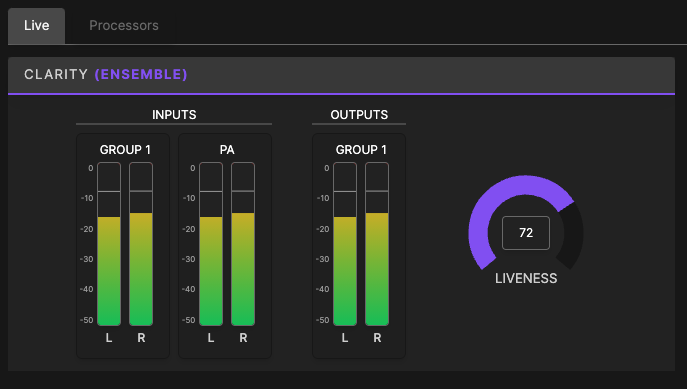
Managing Configurations
Micflex processors periodically save their current configuration data whenever it changes, so they immediately return to their previous state on power up. It is always a good measure to save your configuration locally as a backup in case you have to replace your server or reset it.
Saving
To save your configuration, use the SAVE button located under the FILE menu or use the keyboard shortcut Windows: Ctrl+S, Mac OSX: CMD+S . When you save a copy of the configuration file locally, the Micflex server will mirror the filename you chose for information purposes.
Loading from File
If you've saved your configuration locally, you can reload it from file by choosing FILE > OPEN . Once you open your configuration, VUI will attempt to automatically connect to the servers and show their current status. Refer to the PROCESSORS tab for connection status.
Loading from the Processor
If you don't have your configuration saved locally, or your local configuration is possibly out of date, you can always load the running configuration from the Micflex processor. To do so, ensure that no configurations are currently loaded by choosing FILE > NEW . Then navigate to the PROCESSORS tab and connect to the Micflex processor using the steps outlined previously . Once connected, VUI will automatically fetch the configuration from the Micflex server and load it to your current window.
Console Settings and Mix Strategies
Adjusting microphone input settings
Once Micflex is correctly interfaced with the mixing console, its inputs must be properly calibrated and adjusted. First confirm that the microphone signals feeding Micflex are unprocessed - that is, the microphones do not have equalization, dynamics, or other processing applied. Also, if the microphone submix is onboard the main mixing console, confirm that these input channels and the submix bus are not routed to the PA mix, but only to the Micflex processor.
The only recommended processing of the mic channels is a modest high-pass filter at 60-80Hz (or higher if desired). The microphone input channels and reference bus feeding the Micflex processor should remain on and active at all times. This means that the processor constantly sees an active input level on its inputs, whether or not the microphone returns or insert returns are active in the house mix.
Liveness control
An effect of the Micflex processing is an increased sense of sustain and resonance, relative to the room reverberation of your performance space. This may be modified by using the Liveness control. We recommend initially setting Liveness to its maximum value ( 100 ) for initial setup. If you desire less sustain, slowly reduce the value until the sustain matches your expectations.
To adjust liveness, use the liveness knob to the right of the meters in the Micflex widget. You can adjust the level by either clicking and dragging the purple arc bar or by typing in a value in the middle input field. When typing a value in, you must click away or hit enter for the value to be applied.
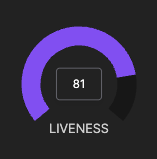
Adjusting signal levels and returns
While the Micflex return channels remain muted at the console, allow the processor to begin listening to its inputs. Slowly raise the Micflex returns in the PA system to a level where the room ambience or nearby sounds can be heard, but below feedback. Allow Micflex to continue listening and adapting. Then, with Micflex returns down and muted in the PA, soundcheck the vocals by having them perform or speak at a typical loudness. Adjust the signals feeding Micflex as necessary to maintain proper input signal level without clipping on its inputs. The main PA mix reference signal (or wedge reference) feeding the Reference inputs should also be trimmed for excellent signal level without clipping.
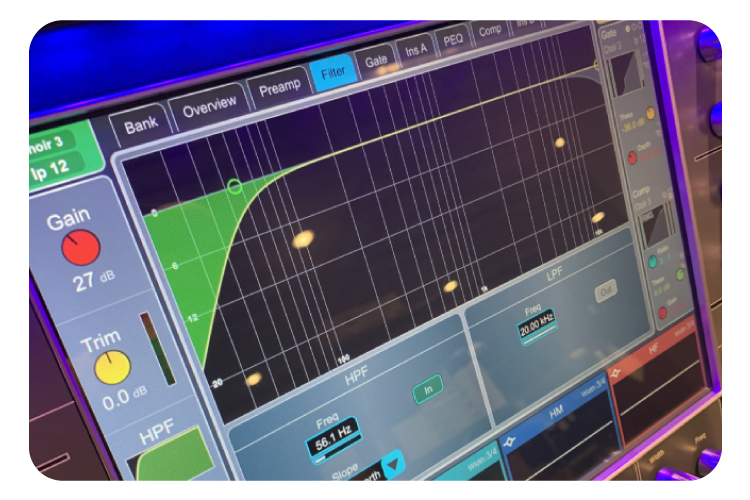
Creating the final mix
Once all inputs of Micflex are receiving proper signal levels, begin mixing the output of Micflex to the PA system (or the local wedges). Raise the return signals slowly in the PA to audition the sound. The processor will continue to listen and adapt. Continue raising the return level slowly to determine the appropriate mix level and gain-before-feedback point.
If any modest equalization is desired for the final sound, it may be applied to these return channels at this time. Note that modifications to equalization may slightly reduce the available gain before feedback.
Tips and observations
Typical Micflex processor installations provide up to 10 dB additional gain-before-feedback margin relative to their unprocessed configurations. In addition, it is often possible to obtain a far more natural, wideband reinforced sound than what was possible without the Micflex processor. This means that low tones, including male voices, may be far more naturally reinforced.
After applying the processor, it is often possible to use a smaller quantity of group microphones at a larger distance from the voices (for applicable modes of operation). This enhances a natural sense of blend and avoids “spotty” coverage or an unnatural reinforced quality.
At higher gain levels, Micflex adds a natural reverberant decay to the sound, generated from real reflections inside the room. This can be varied by the amount of overall gain on the return channels by the mix engineer, as well as by adjusting the Liveness parameter.
Specifications
| Power Supply | Internal 100V-240V, 6.5A-3.5A at 50/60 Hz |
| Power Consumption | 450W |
| Audio Input | Up to 16 Channels of Dante™ network audio (48kHz only) |
| Audio Output | Up to 8 Channels of Dante™ network audio (48kHz only) |
| Frequency Response | 20Hz to 20kHz |
| Latency | 5.33-21.33 ms (depending on mode) plus Dante™ network latency (minimum Dante™ latency 1 ms) |
| Network | 1000/100 Mbps ethernet for Dante™ and Control, 1000/100 Mbps ethernet for optional Control |
| Dimensions (W x H x D) | 434 x 42.8 x 595.6 mm (17.1 x 1.69 x 23.5 in) 1 |
| Weight | 12.2 kg (29.9 lb), accessories and packaging not included |
- 1 Dimensions do not include bezel